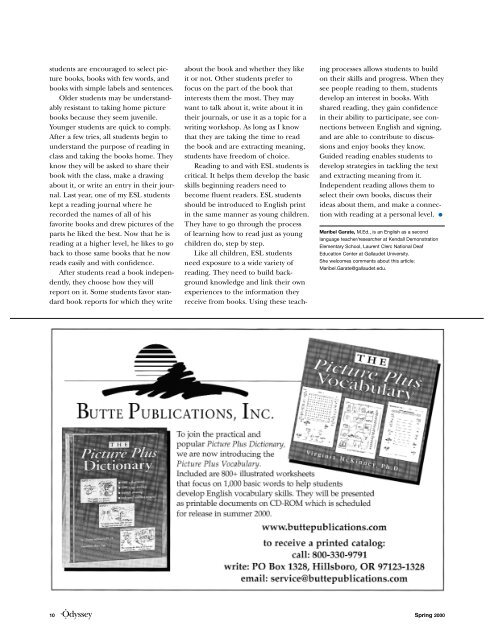Deaf ESL Students - Gallaudet University
Deaf ESL Students - Gallaudet University
Deaf ESL Students - Gallaudet University
Create successful ePaper yourself
Turn your PDF publications into a flip-book with our unique Google optimized e-Paper software.
students are encouraged to select picture<br />
books, books with few words, and<br />
books with simple labels and sentences.<br />
Older students may be understandably<br />
resistant to taking home picture<br />
books because they seem juvenile.<br />
Younger students are quick to comply.<br />
After a few tries, all students begin to<br />
understand the purpose of reading in<br />
class and taking the books home. They<br />
know they will be asked to share their<br />
book with the class, make a drawing<br />
about it, or write an entry in their journal.<br />
Last year, one of my <strong>ESL</strong> students<br />
kept a reading journal where he<br />
recorded the names of all of his<br />
favorite books and drew pictures of the<br />
parts he liked the best. Now that he is<br />
reading at a higher level, he likes to go<br />
back to those same books that he now<br />
reads easily and with confidence.<br />
After students read a book independently,<br />
they choose how they will<br />
report on it. Some students favor standard<br />
book reports for which they write<br />
about the book and whether they like<br />
it or not. Other students prefer to<br />
focus on the part of the book that<br />
interests them the most. They may<br />
want to talk about it, write about it in<br />
their journals, or use it as a topic for a<br />
writing workshop. As long as I know<br />
that they are taking the time to read<br />
the book and are extracting meaning,<br />
students have freedom of choice.<br />
Reading to and with <strong>ESL</strong> students is<br />
critical. It helps them develop the basic<br />
skills beginning readers need to<br />
become fluent readers. <strong>ESL</strong> students<br />
should be introduced to English print<br />
in the same manner as young children.<br />
They have to go through the process<br />
of learning how to read just as young<br />
children do, step by step.<br />
Like all children, <strong>ESL</strong> students<br />
need exposure to a wide variety of<br />
reading. They need to build background<br />
knowledge and link their own<br />
experiences to the information they<br />
receive from books. Using these teach-<br />
ing processes allows students to build<br />
on their skills and progress. When they<br />
see people reading to them, students<br />
develop an interest in books. With<br />
shared reading, they gain confidence<br />
in their ability to participate, see connections<br />
between English and signing,<br />
and are able to contribute to discussions<br />
and enjoy books they know.<br />
Guided reading enables students to<br />
develop strategies in tackling the text<br />
and extracting meaning from it.<br />
Independent reading allows them to<br />
select their own books, discuss their<br />
ideas about them, and make a connection<br />
with reading at a personal level. ●<br />
Maribel Garate, M.Ed., is an English as a second<br />
language teacher/researcher at Kendall Demonstration<br />
Elementary School, Laurent Clerc National <strong>Deaf</strong><br />
Education Center at <strong>Gallaudet</strong> <strong>University</strong>.<br />
She welcomes comments about this article:<br />
Maribel.Garate@gallaudet.edu.<br />
10 Spring 2000
















